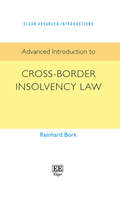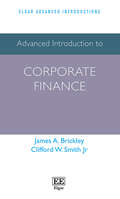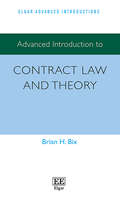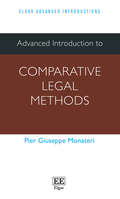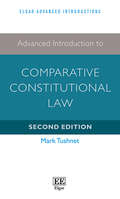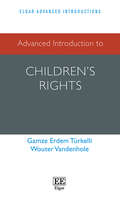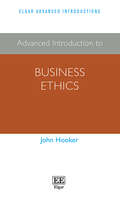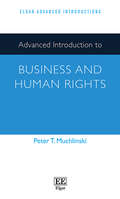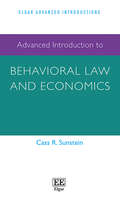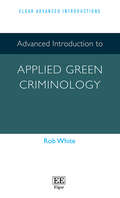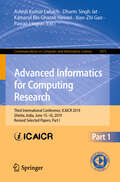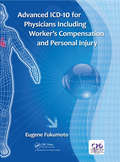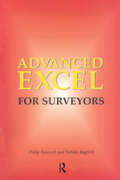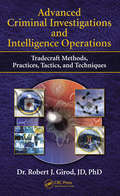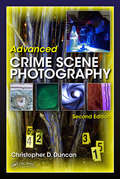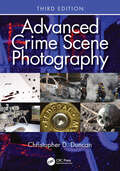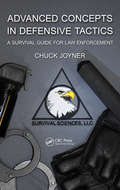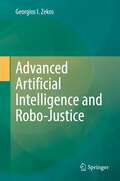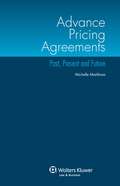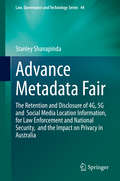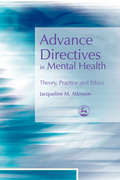- Table View
- List View
Advanced Introduction to Cross-Border Insolvency Law (Elgar Advanced Introductions series)
by Reinhard BorkElgar Advanced Introductions are stimulating and thoughtful introductions to major fields in the social sciences, business and law, expertly written by the world’s leading scholars. Designed to be accessible yet rigorous, they offer concise and lucid surveys of the substantive and policy issues associated with discrete subject areas.The Advanced Introduction to Cross-Border Insolvency Lawprovides a clear and concise overview of cross-border insolvency law with particular focus on the rules governing insolvency proceedings that occur between and across countries. Increasingly, such proceedings have an international dimension, which may involve, for example, debtors with assets abroad, foreign creditors, contractual agreements with counterparties in different jurisdictions, or companies with offices or subsidiaries in a different country. The book expertly steers the reader through the complex interactions between national and supra-national rules, international model laws, and the principles that underpin them. Key Features:Uses numerous practical examples to illustrate key conceptsProvides both in-depth information for advanced readers and accessible information for beginners in the fieldSuccinctly evaluates case law and literatureFollows a comparative law approach with a principle-based methodology in order to fully explore the most important issuesThis enlightening Advanced Introduction will be of great benefit to those studying company, commercial, and private international law, as well as to the non-specialist practitioner. Insolvency scholars will also appreciate the astute insights.
Advanced Introduction to Corporate Finance (Elgar Advanced Introductions series)
Elgar Advanced Introductions are stimulating and thoughtful introductions to major fields in the social sciences, business and law, expertly written by the world’s leading scholars. Designed to be accessible yet rigorous, they offer concise and lucid surveys of the substantive and policy issues associated with discrete subject areas. This Advanced Introduction presents the modern theories of corporate finance. Its focus on core concepts offers useful managerial insights, bolstered by recent empirical evidence, to provide a richer understanding of critical corporate financial policy decisions.Key features include:A modern approach to corporate financial theory and evidenceKey research presented in a structured mannerConcepts explained in an intuitive, example-filled manner that does not require a strong mathematics backgroundDetailed references for those wishing further reading on particular topics.Within business programs, the book offers an insightful introduction for courses on corporate finance, but also can be employed as a supplementary text in broader business courses. Experienced managers in financial functions will find the book a useful review and update of material developed since earning their degrees. Given the increasing use of cross-functional teams within the business community, the book provides a richer understanding of corporate financial policy choices for managers across a broad array of business functions.
Advanced Introduction to Contract Law and Theory (Elgar Advanced Introductions series)
by Brian H. BixElgar Advanced Introductions are stimulating and thoughtful introductions to major fields in the social sciences, business and law, expertly written by the world’s leading scholars. Designed to be accessible yet rigorous, they offer concise and lucid surveys of the substantive and policy issues associated with discrete subject areas.This comprehensive Advanced Introduction provides an overview of contract law and contemporary contract theory. Demonstrating that an understanding of theory and policy is a vital aspect of being an effective practicing lawyer, Brian H. Bix explores the various theoretical approaches which can best explain and justify contract law, arguing for greater critical attention to the connections between contract law theory, practice, and teaching.Key Features:Concise and accessible formatCombines analysis of contract doctrine and theoryIncludes detailed Restatement, UCC and case referencesAnalyses the strengths and weakness of a variety of theoretical approachesExamines contract law formation, interpretation, performance, the right of duties of third persons, and remediesThe Advanced Introduction to Contract Law and Theory will be an invaluable resource for students wanting to understand contract law and its theoretical underpinnings. It will also prove an essential guide for scholars seeking an authoritative guide to current doctrine and debates in the field of contract law.
Advanced Introduction to Comparative Legal Methods (Elgar Advanced Introductions series)
by Pier MonateriElgar Advanced Introductions are stimulating and thoughtful introductions to major fields in the social sciences, business and law, expertly written by the world’s leading scholars. Designed to be accessible yet rigorous, they offer concise and lucid surveys of the substantive and policy issues associated with discrete subject areas. Drawing on historical, normative, theoretical, and economic methodologies, Pier Giuseppe Monateri offers a fresh critical analysis of various dimensions of comparative law methods. Comprehensive and engaging with a multidisciplinary approach, this Advanced Introduction spans the fields of comparative legal studies, law and finance and global law. Key features include: uses analysis of current issues to offer a genuinely advanced perspectiveuse of theory for evaluating methods and approaches in comparative lawa comprehensive treatment of the main themes and approaches in comparative law discussions. This insightful Advanced Introduction will be an excellent resource for both law students and scholars alike. It will also be a useful guide for those working in international law, as well as law clerks and legal advisors.Professor Emeritus, Kent Law School, UK
Advanced Introduction to Comparative Constitutional Law: Second Edition (Elgar Advanced Introductions series)
by Mark TushnetElgar Advanced Introductions are stimulating and thoughtful introductions to major fields in the social sciences and law, expertly written by the world’s leading scholars. Designed to be accessible yet rigorous, they offer concise and lucid surveys of the substantive and policy issues associated with discrete subject areas. Mark Tushnet, a world-renowned scholar of constitutional law, has excelled in extending and revising his essential introduction to comparative constitutional law. Through an analysis of topics at the cutting edge of contemporary scholarship, this authoritative study investigates constitution making, forms of constitutional review, proportionality analysis and its alternatives, and the development of a new ‘transparency’ branch in constitutions around the world. Throughout, the book draws upon examples from a wide range of nations, demonstrating that the field of comparative constitutional law now truly encompasses the world. New to this revised and enlarged second edition: • Updated and extended material to encompass the developments in practice and scholarship since the original edition’s publication back in 2014 • With substantial additional attention, Tushnet analyses abusive constitutionalism, the idea of the constituent power, eternity clauses and unconstitutional amendments • Recent developments in weak- and strong-form constitutional review are given fresh analysis, as well as an expanded consideration of third generation rights. Addressing the key issues of constitutional design and structure, this second edition will serve as an excellent up-to-date resource for students and scholars of comparative constitutional law.
Advanced Introduction to Children’s Rights (Elgar Advanced Introductions series)
by Gamze Erdem Türkelli Wouter VandenholeElgar Advanced Introductions are stimulating and thoughtful introductions to major fields in the social sciences, business and law, expertly written by the world’s leading scholars. Designed to be accessible yet rigorous, they offer concise and lucid surveys of the substantive and policy issues associated with discrete subject areas.This Advanced Introduction offers a succinct yet comprehensive introduction to the multidisciplinary field of children’s rights. Inspired by the dilemma of difference in the discussion of children’s rights, chapters explore the equal rights that children share with adults as well as their differentiated and special rights.Key Features:Accessible, conceptually-grounded exploration of the contemporary children's rights debatesInclusive and multifaceted overview of children’s rights within the human rights paradigmForward looking perspectives and discussion of the future of children’s rightsApproaching the topic of children’s rights firmly within the human rights paradigm, this Advanced Introduction will be a valuable companion for students and academics interested in children's rights, human rights and international law. Legal scholars and policy-makers looking to gain insight into key areas in children's rights will also find this book an interesting read.
Advanced Introduction to Business Ethics (Elgar Advanced Introductions series)
by John HookerElgar Advanced Introductions are stimulating and thoughtful introductions to major fields in the social sciences, business and law, expertly written by the world’s leading scholars. Designed to be accessible yet rigorous, they offer concise and lucid surveys of the substantive and policy issues associated with discrete subject areas.This concise and engaging Advanced Introduction provides the conceptual tools necessary to make ethical decisions in today’s business world. John Hooker provides an objective and closely-reasoned analysis of ethical issues based on a unified conceptual framework that distils the best of ethical thought into three clearly articulated principles: the generalization, utilitarian, and autonomy principles. Key features include:examples and case studies that illustrate ethical reasoning in complex business dilemmas exploration of business ethics in relation to environmental, social, and financial sustainability factorscoverage of cross-cultural business ethics, technological unemployment, and the ethics of artificial intelligence and machine learning.This Advanced Introduction will be a valuable resource for academics and advanced students of business ethics and trust, business leadership, and corporate social responsibility. It will also be beneficial for business managers who wish to build an ethical organization, as well as technical personnel who incorporate ethics into automated systems.
Advanced Introduction to Business and Human Rights (Elgar Advanced Introductions series)
by Peter T. MuchlinskiElgar Advanced Introductions are stimulating and thoughtful introductions to major fields in the social sciences, business and law, expertly written by the world’s leading scholars. Designed to be accessible yet rigorous, they offer concise and lucid surveys of the substantive and policy issues associated with discrete subject areas.Focusing on the adoption of the UN Guiding Principles on Business and Human Rights (UNGPs) in 2011, this timely book charts the field of business and human rights, finding that corporate responsibility to respect human rights is gradually evolving into a binding legal duty in both national and international law. Following the structure of the UNGPs, Peter T. Muchlinski also covers the state duty to protect against business violations of human rights, the corporate responsibility to respect human rights and access to remedies for corporate violations of human rights.Key Features:A detailed, critical, appraisal of the UNGPs in their historical, legal and political contextsCoverage of developments in national law and policy to further the state’s duty to protect against business violations of human rightsAn interdisciplinary perspective drawing on history, law, business ethics, politics, and ideas of corporate governance with a view to introducing the field to readers with diverse specialist backgroundsCoverage of new directions for business and human rights including calls for new mandatory corporate liability laws, a legally binding international treaty and new multi stakeholder initiatives for developing business and human rights standardsThis Advanced Introduction will be a key guide for students and researchers in the fields of business and human rights, international law and business ethics, as well as lawyers and business managers who need an accessible primer to business and human rights.
Advanced Introduction to Behavioral Law and Economics (Elgar Advanced Introductions series)
by Cass R. SunsteinElgar Advanced Introductions are stimulating and thoughtful introductions to major fields in the social sciences, business and law, expertly written by the world’s leading scholars. Designed to be accessible yet rigorous, they offer concise and lucid surveys of the substantive and policy issues associated with discrete subject areas.This highly informative Advanced Introduction explores the diverse and far-reaching legal implications of some of the key findings of behavioral economics. Cass Sunstein, a leader in this field, adopts an interdisciplinary approach to examining cutting-edge topics such as air pollution and climate change; public health and safety; pandemic response; occupational safety; road safety; and contract, property, and tort law. This Advanced Introduction provides a much-needed assessment and analysis of the law as a critical domain for the use of behavioral economics, and investigates how techniques including nudging, mandates, and taxes can be used to enhance the effectiveness and improve the implementation of the law.Key Features:Explains how legal systems and governments employ behavioral economicsExplores the crucial relationship between law, behavioral economics and human welfareHighlights the use of algorithms in law and policy, considering the relationship between algorithms, noise and bias Examines key concepts from behavioral economics including sludge, present bias, loss aversion, unrealistic optimism, and anchoringThis erudite Advanced Introduction will be an essential read for legal students, academics and researchers with an interest in behavioral economics, public policy and economic psychology. Highlighting how behavioral economics interacts with various other disciplines, it will also prove valuable to professionals and practitioners working in law, medicine, education and politics.
Advanced Introduction to Applied Green Criminology (Elgar Advanced Introductions series)
by Rob WhiteElgar Advanced Introductions are stimulating and thoughtful introductions to major fields in the social sciences, business and law, expertly written by the world’s leading scholars. Designed to be accessible yet rigorous, they offer concise and lucid surveys of the substantive and policy issues associated with discrete subject areas.The Advanced Introduction to Applied Green Criminology provides a comprehensive overview of interventions and practices that contribute to environmental protection. Topics include crime prevention, environmental regulation and law enforcement, environmental forensics, greening of criminal justice institutions, and social activism. Underpinning these topics is the notion of eco-justice, which focuses on environmental justice (humans), ecological justice (ecosystems) and species justice (non-human animals and plants). Key Features:Discusses practical ways to prevent and stop environmental crimes and harmsPresents grounded examples and knowledge gained from years of experience and expertise reflecting a 'pracademic' orientationProvides insightful summaries of intervention practicesThis Advanced Introduction will be invaluable to practitioners, such as green criminologists, conservation scientists, and environmental lawyers and regulators, as well as academics and students interested in preventing, stopping, and deterring environmental crimes and harms.?
Advanced Informatics for Computing Research: Third International Conference, ICAICR 2019, Shimla, India, June 15–16, 2019, Revised Selected Papers, Part I (Communications in Computer and Information Science #1075)
by Ashish Kumar Luhach Dharm Singh Jat Kamarul Bin Ghazali Hawari Xiao-Zhi Gao Pawan LingrasThis two-volume set (CCIS 1075 and CCIS 1076) constitutes the refereed proceedings of the Third International Conference on Advanced Informatics for Computing Research, ICAICR 2019, held in Shimla, India, in June 2019. The 78 revised full papers presented were carefully reviewed and selected from 382 submissions. The papers are organized in topical sections on computing methodologies; hardware; information systems; networks; software and its engineering.
Advanced ICD-10 for Physicians Including Worker’s Compensation and Personal Injury
by Eugene FukumotoICD-10 is the 10th revision of the International Statistical Classification of Diseases and Related Health Problems (ICD), a medical classification list by the World Health Organization. It contains codes for diseases, signs and symptoms, abnormal findings, complaints, social circumstances, and external causes of injury of diseases. The code set allows more than 14,000 different codes and permits the tracking of many new diagnoses. The U.S. has used ICD-10-CM (Clinical Modification) since October, 2015. This national variant of ICD-10 was provided by the Centers for Medicare and Medicaid Services (CMS) and the National Center for Health Statistics, and the use of ICD-10-CM codes are now mandated for all inpatient medical reporting requirements. This book is for physicians, practice managers and all others who need learn ICD-10. It’s designed for the clinician to learn how to put their diagnosis into a code and not rely on staff or computer software programs to decide it form them. ICD-10 is a complex system of coding and Medicare and third party insurers have been lenient giving providers a year to get used to the coding system. As a result, physicians and their staff have become very complacent regarding proper coding. However, Medicare and third party insurers will soon begin to deny claims which are not coded correctly, which in turn will cost physician groups time and money. This book focuses on Worker’s Compensation and Personal Injury, a very large segment of the healthcare industry and is a new area to ICD-10. The diagnosis coding for injuries is much different than for Medicare or group insurance and unless the physicians and their staff learn how to use it properly, they risk losing income for themselves and worse, they risk losing the case for the patient.
Advanced ICD-10 for Physicians Including Worker’s Compensation and Personal Injury
by Eugene FukumotoICD-10 is the 10th revision of the International Statistical Classification of Diseases and Related Health Problems (ICD), a medical classification list by the World Health Organization. It contains codes for diseases, signs and symptoms, abnormal findings, complaints, social circumstances, and external causes of injury of diseases. The code set allows more than 14,000 different codes and permits the tracking of many new diagnoses. The U.S. has used ICD-10-CM (Clinical Modification) since October, 2015. This national variant of ICD-10 was provided by the Centers for Medicare and Medicaid Services (CMS) and the National Center for Health Statistics, and the use of ICD-10-CM codes are now mandated for all inpatient medical reporting requirements. This book is for physicians, practice managers and all others who need learn ICD-10. It’s designed for the clinician to learn how to put their diagnosis into a code and not rely on staff or computer software programs to decide it form them. ICD-10 is a complex system of coding and Medicare and third party insurers have been lenient giving providers a year to get used to the coding system. As a result, physicians and their staff have become very complacent regarding proper coding. However, Medicare and third party insurers will soon begin to deny claims which are not coded correctly, which in turn will cost physician groups time and money. This book focuses on Worker’s Compensation and Personal Injury, a very large segment of the healthcare industry and is a new area to ICD-10. The diagnosis coding for injuries is much different than for Medicare or group insurance and unless the physicians and their staff learn how to use it properly, they risk losing income for themselves and worse, they risk losing the case for the patient.
Advanced Excel for Surveyors
by Philip Bowcock Natalie BayfieldAdvanced Excel for Surveyors is the companion to the highly successful Excel for Surveyors. This volume is intended to help both students and practitioners use Mircosoft Excel™ to solve some of the more complex problems that the surveyor may come across.It explores how Visual Basic and macros can simplify and speed up repetitive tasks, fulfilling one of the basic aims of computing: “If it is repetitive teach the machine to do this for you”. The methodology of portfolio analysis is a relatively new discipline, which may be unfamiliar to many readers. The book provides an introduction to the principles and shows how Excel can help, readers may even find this of help when assessing their own personal investment portfolios. Further ideas for setting up databases; how to arrange for several surveyors to work on a single project; data analysis; and the use of charts in Reports are discussed together with further advice on security and protection.
Advanced Excel for Surveyors
by Philip Bowcock Natalie BayfieldAdvanced Excel for Surveyors is the companion to the highly successful Excel for Surveyors. This volume is intended to help both students and practitioners use Mircosoft Excel™ to solve some of the more complex problems that the surveyor may come across.It explores how Visual Basic and macros can simplify and speed up repetitive tasks, fulfilling one of the basic aims of computing: “If it is repetitive teach the machine to do this for you”. The methodology of portfolio analysis is a relatively new discipline, which may be unfamiliar to many readers. The book provides an introduction to the principles and shows how Excel can help, readers may even find this of help when assessing their own personal investment portfolios. Further ideas for setting up databases; how to arrange for several surveyors to work on a single project; data analysis; and the use of charts in Reports are discussed together with further advice on security and protection.
Advanced Criminal Investigations and Intelligence Operations: Tradecraft Methods, Practices, Tactics, and Techniques
by Robert J GirodTradecraft is a term used within the intelligence community to describe the methods, practices, and techniques used in espionage and clandestine investigations. Whether the practitioner is a covert agent for the government or an identity thief and con man, the methods, practices, tactics, and techniques are often the same and sometimes learned from
Advanced Crime Scene Photography
by Christopher D DuncanThe ability to thoroughly and properly document a crime scene through photography is a must for crime scene investigators. Regardless of the time of day, weather conditions, or confines in which a piece of evidence is concealed, photographs must be true and accurate. Capturing all the pertinent information and evidence for use during an investigati
Advanced Crime Scene Photography
by Christopher D. DuncanThe ability to thoroughly and accurately photograph a crime scene is a mandate for all investigators, regardless of the time of day, weather conditions, or confines within which a piece of evidence is concealed. Evidence is commonly found in locations that are some of the most difficult to access and photograph. Having the knowledge, wherewithal, and skills necessary to photograph evidence in less-than-accommodating environments is vital to a photographer’s effectiveness and success. Advanced Crime Scene Photography, Third Edition takes a somewhat different approach to the subject over prior editions. Rather than assuming a crime scene investigator’s or photographer’s comfort with the operation of their cameras—and a basic understanding of apertures, shutter speeds, ISO values, and basic exposure calculations—the author has added coverage to provide a thorough review of basic photographic concepts, as a refresher to readers. And, for those less familiar or otherwise new to photography, such background makes the foundational concepts more understandable for those readers who require such information to understand the more advanced techniques covered later in the book. In addition to this background coverage, an entirely new chapter has been added to provide essential guidance on how to prepare and testify in court. Anyone with a camera phone can take a photograph in perfect lighting, with the subject sitting out in the open, and already positioned for the best composition. This book provides crime scene photographers with the skills necessary to record those same beautiful photographs in adverse condition, surrounded by tragedy, utilizing all the tools available to the investigator. The greatest tool a photographer has available to them is their brain. From start to finish, the value of quality crime scene photographs cannot be overemphasized; photographers must take control of their photographic endeavors, identify the challenges, design a plan to capture the image correctly, and then execute that plan. As such Advanced Crime Scene Photograph, Third Edition is written to help photographers achieve the goal of capturing the best possible images—especially in those difficult-to-capture, real-world environments and conditions—for utilization in capture illustrative images as admissible evidence and for usage in court. All photographers need to practice their craft, whether they are actively working cases as seasoned veterans or are just beginning their careers. This book provides the knowledge and skills essential to achieve career and professional success in crime scene photography.
Advanced Crime Scene Photography
by Christopher D. DuncanThe ability to thoroughly and accurately photograph a crime scene is a mandate for all investigators, regardless of the time of day, weather conditions, or confines within which a piece of evidence is concealed. Evidence is commonly found in locations that are some of the most difficult to access and photograph. Having the knowledge, wherewithal, and skills necessary to photograph evidence in less-than-accommodating environments is vital to a photographer’s effectiveness and success. Advanced Crime Scene Photography, Third Edition takes a somewhat different approach to the subject over prior editions. Rather than assuming a crime scene investigator’s or photographer’s comfort with the operation of their cameras—and a basic understanding of apertures, shutter speeds, ISO values, and basic exposure calculations—the author has added coverage to provide a thorough review of basic photographic concepts, as a refresher to readers. And, for those less familiar or otherwise new to photography, such background makes the foundational concepts more understandable for those readers who require such information to understand the more advanced techniques covered later in the book. In addition to this background coverage, an entirely new chapter has been added to provide essential guidance on how to prepare and testify in court. Anyone with a camera phone can take a photograph in perfect lighting, with the subject sitting out in the open, and already positioned for the best composition. This book provides crime scene photographers with the skills necessary to record those same beautiful photographs in adverse condition, surrounded by tragedy, utilizing all the tools available to the investigator. The greatest tool a photographer has available to them is their brain. From start to finish, the value of quality crime scene photographs cannot be overemphasized; photographers must take control of their photographic endeavors, identify the challenges, design a plan to capture the image correctly, and then execute that plan. As such Advanced Crime Scene Photograph, Third Edition is written to help photographers achieve the goal of capturing the best possible images—especially in those difficult-to-capture, real-world environments and conditions—for utilization in capture illustrative images as admissible evidence and for usage in court. All photographers need to practice their craft, whether they are actively working cases as seasoned veterans or are just beginning their careers. This book provides the knowledge and skills essential to achieve career and professional success in crime scene photography.
Advanced Concepts in Defensive Tactics: A Survival Guide for Law Enforcement
by Chuck JoynerToday‘s society is becoming increasingly more likely to resist the lawful actions of law enforcement officers. It is critical for officers to have the necessary defensive tactics (DT) skills to successfully overcome resistance in an efficient, safe, and legal manner. The answer to achieving these results is NOT in teaching thousands of possible res
Advanced, Automated and Electric Vehicle Law
by Mr Alex Glassbrook'A comprehensive and informative guide to the law, set in its historical and technical context, by an author with a deep understanding of transformative technology could not be more timely. I can think of no better guide in this field than Alex Glassbrook.' From the Foreword by Mr Justice SweetingThe era of advanced, automated and electric vehicles (AAEVs) has begun; the legal transformation is starting.In July 2018, Parliament enacted the Automated and Electric Vehicles Act 2018, legislating for electric vehicle charging and allowing a direct civil claim against the motor insurer of an automated, 'self-driving' vehicle. In May 2022, the UK government announced its intention to create a new legal category for e-scooters. In April 2023, a 'hands free' advanced driver assistance system was approved for use on certain motorways across England, Wales and Scotland.On 8 November 2023 the Automated Vehicles Bill 2023-24 (HL Bill 1) had its first reading in Parliament.Motor vehicle technologies have developed since the nineteenth century and have affected numerous aspects of our lives - from road safety to the environment, from the laws of negligence and contribution to the rules of compulsory insurance. As AAEV technologies proliferate, their effects are likely to spread further.This book describes the emerging laws of advanced, automated and electric vehicles in England and Wales, explaining- The insurance and liability reforms of the Automated and Electric Vehicles Act 2018- The wider regulatory reforms of the Automated Vehicles Bill 2023-24, set to become the Automated Vehicles Act 2024- The range of legal practice areas affected by AAEVs, including discussions of the new public laws of vehicle safety, the actionability of downloaded software, electronic disclosure in civil litigation and the law of testing prototypes. This book will help those litigating, adjudicating, regulating and studying AAEV issues. It gives the context and detail of AAEV law in its many applications. It is a map to a fast-changing legal landscape.This title is included in Bloomsbury Professional's Cyber Law online service.
Advanced Artificial Intelligence and Robo-Justice
by Georgios I. ZekosThe book deals with digital technology which is transforming the landscape of dispute resolution. It illustrates the application of AI in the legal field and shows the future prospect of robo-justice for an AAI society in the advanced artificial intelligence era. In other words, the present justice system and the influence of current AI upon courts and arbitration are investigated. The transforming role of AI on all legal fields is examined thoroughly by giving answers concerning AI legal personality and liability. The analysis shows that digital technology is generating an ever-growing number of disputes and at the same time is challenging the effectiveness and reach of traditional dispute resolution avenues. To that extent, the book presents in tandem the impact of AI upon courts and arbitration, and reveals the role of AAI in generating a new robo-justice system.Finally, the end of the perplexing relation of courts and arbitration is evidenced methodically and comprehensively.
Advance Pricing Agreements: Past, Present and Future
by Michelle MarkhamTransfer pricing (the pricing of cross-border intra-firm transactions between related parties) is now the top international tax issue faced by multinational enterprises. In an international taxation environment characterized by rigorous enforcement of transfer pricing documentation, disclosure, and audit processes, a need has arisen for multinationals to be cognizant of the impact of their ‘tax risk appetite’ on their relationship with taxation authorities and to be aware of how best to manage their transfer pricing arrangements. The most promising development has been the growing commitment to Advance Pricing Agreements (APAs) – arrangements made prospectively between a multinational taxpayer and one or more revenue authorities, agreeing on an appropriate set of criteria for the determination of the transfer pricing of the covered transactions over a period of time. This is the first book to offer expert insights on APAs from a practical perspective. By focusing on the United States and Australia, the two countries that were at the forefront of adopting APAs and whose wealth of experience over two decades confirms their APA programs as the global paradigms, the author is able to highlight the advantages and disadvantages of pursuing an APA and to shed light on the powerful efficacy of this strategy for avoiding transfer pricing disputes. In addition, the author enlists the views of revenue authorities, transfer pricing practitioners, and corporate counsel who deal with the realities of transfer pricing assessment and compliance on an ongoing basis, offering acute insight into how APAs really work in a practical way. This book contributes to the body of knowledge on APAs in the context of transfer pricing by providing in-depth scrutiny of the most important issues surrounding this critical area, and by examining innovations in APAs in the United States and in Australia. Its unmatched coverage will be welcomed by tax experts at law firms and multinational companies as well as by revenue officials, policymakers, and scholars and researchers in international taxation.
Advance Metadata Fair: The Retention and Disclosure of 4G, 5G and Social Media Location Information, for Law Enforcement and National Security, and the Impact on Privacy in Australia (Law, Governance and Technology Series #44)
by Stanley ShanapindaThis book outlines the legal powers of a major Western nation – Australia – to collect and use location information. Mobile service and social media service providers now have the ability to track, record and store more precise location information. Unlike 4G, 5G mobile communications require that cell towers and antennas be in much closer proximity; as a result, the location data can reveal more personal and sensitive information about individual citizens. Despite this aspect, service providers are required to disclose the data to the authorities, without the need for a judicial warrant. This book was written from the perspective of big location data software analytics, a capability that makes it possible to combine various location data points to create a profile on a given individual’s movements, habits, and political, religious and ideological orientation. In this regard, privacy is poorly protected. The rationale used to justify the powers was enforcing serious crimes – terrorism offences. Location data can now be retained for at least two years and be collected to investigate even minor offences. This can be done without the person being reasonably suspected of a criminal offence – when the individual is simply determined to be a person of interest. This poses legal risks to vulnerable communities. And yet, such investigative techniques are deemed lawful and reasonable. At a time when national security is so broadly defined to include economic issues, which in turn overlap with climate change and environmental protection, these legal powers should be reassessed. The book clarifies the complex rules that every citizen must know in order to have agency. Further, it calls upon authorities to reflect and to self-regulate, by making the conscious decision to surrender some of their powers to review by the independent judiciary. Without the requirement for a judicial warrant or judicial review, the powers are unfairly broad. The book pursues an interdisciplinary approach to assess the functionality of mobile telecommunications in direct relation to law enforcement powers and existing judicial precedents. Further, it offers a unifying techno-legal perspective on a complex issue touching on modern privacy law and communications technologies.
Advance Directives in Mental Health: Theory, Practice and Ethics (PDF)
by Jacqueline AtkinsonAn advance directive is a way of making a person's views known if he or she should become mentally incapable of giving consent to treatment, or making informed choices about treatment, at some future time. Advance Directives in Mental Health is a comprehensive and accessible guide for mental health professionals advising service users on their choices about treatment in the event of future episodes of mental illness, covering all ideological, legal and medical aspects of advance directives. Jacqueline Atkinson explains their origins and significance in the context of mental health legislation and compares advance directives in mental health with those in other areas of medicine like dementia or terminal illness, offering a general overview of the differences in the laws of various English-speaking countries. She explores issues of autonomy and responsibility in mental health and gives practical advice on how to set up, implement and change advance directives. The book offers a useful overview of advance directives and is a key reference for all mental health professionals as well as postgraduate students, lawyers who work with mentally ill people, service users and their families and carers.
